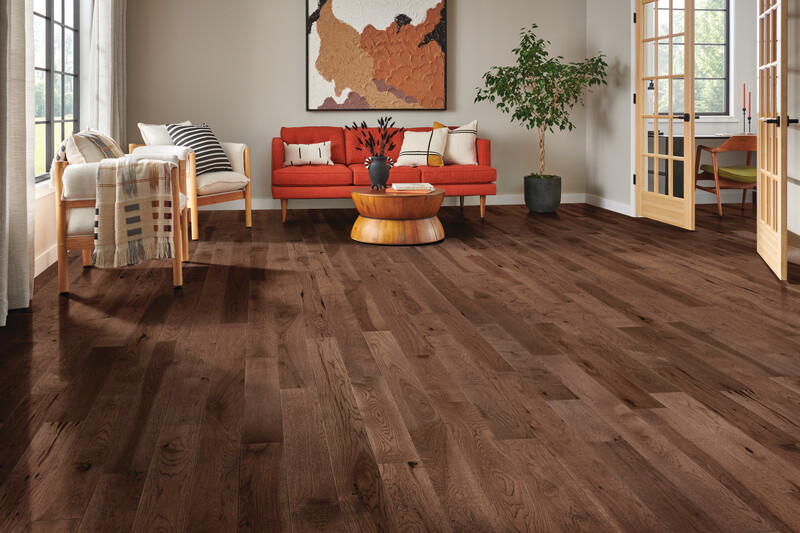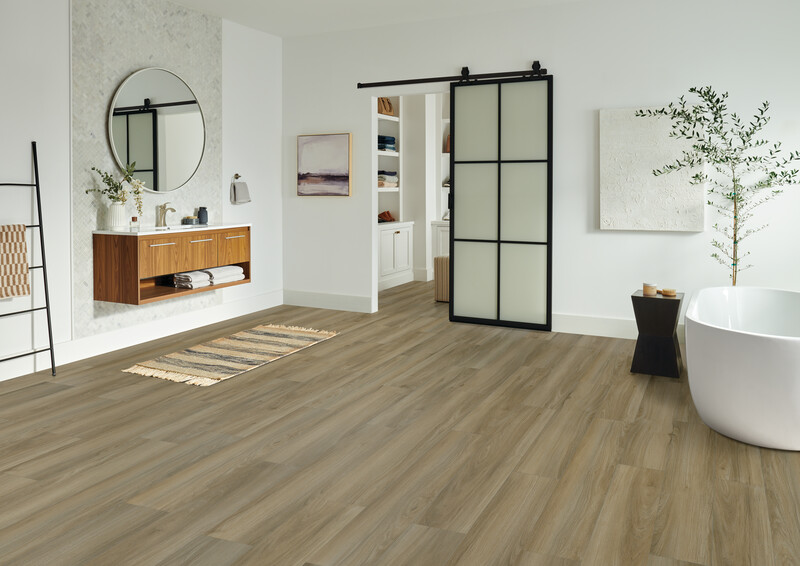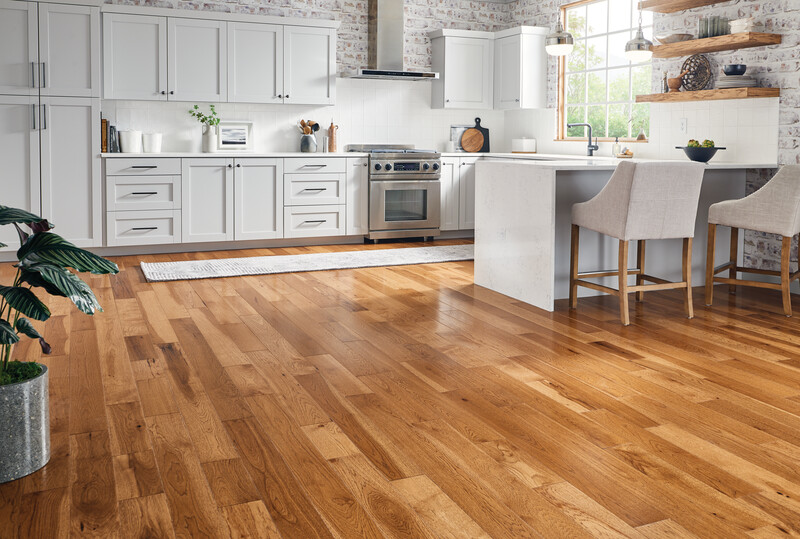A Comprehensive Guide to Hardwood Flooring
February 19, 2025
Your journey to beautiful hardwood floors begins with understanding how this timeless flooring option can transform your home. This guide will walk you through the key decisions, design principles, and maintenance practices that ensure your hardwood floors brighten your living spaces for years.

Choose Hardwoods That Fit Your Lifestyle
The path to perfect hardwood flooring starts with understanding your home’s unique needs. Consider three fundamental factors:
- Your lifestyle
- Home environment
- Design vision
Each concern is crucial in determining the ideal flooring solution for your space.
The Impact of Lifestyle on Hardwood Flooring Selection
Your lifestyle encompasses everything from family size to pet ownership, entertainment frequency, and daily routines. Active families, for instance, with children and pets, should prioritize durability and maintenance ease. That speaks to harder woods and flooring options.
For example, engineered hardwoods and wood-look flooring typically deliver more scratch and dent resistance than solid hardwoods. Companies like Robbins® even offer specialty flooring designed to take punishment.
ArmorWood™ dog-friendly wood flooring is an engineered floor that offers four times the scratch resistance and six times the dent resistance of standard hardwoods. It’s also waterproof for occasional pet accidents.
The recently released Ingenious Plank® also fits the bill. This hybrid resilient flooring is 100% waterproof and offers superior scratch and dent resistance. It also offers an added plus—the flooring is PVC-free.
Your Home’s Environment Helps Determine Wood Flooring Selection
Your home’s environment includes climate, humidity levels, and subfloor conditions. Homes in regions with significant seasonal changes face challenges different from those in more stable climates. Understanding these environmental factors helps narrow your options to those that will perform best in your situation.
People living in the South face high humidity and temperature fluctuations that can cause solid wood floors to expand and contract. The same is true for basement flooring, where moist conditions often prevail.
These conditions call for water-resistant flooring, such as engineered hardwood or rigid core flooring. Both handle moisture, ensuring your floors don’t cup or warp.
What’s Your Design Style?
Performance aside, your design vision plays a critical role in flooring selection. Consider not just current trends but timeless appeal. Remember, solid hardwoods can last for generations, so you want to choose a hardwood that looks good today and tomorrow.
Fortunately, hardwood manufacturers serve up plenty of design options. Robbins, for example, has more than 150 solid and engineered hardwood options. They also offer wood-look flooring options, giving you even more design freedom.
Your choices run the gamut:
- Colors
- Finishes like hand-scraped, rustic, distressed wood, and traditional
- Plank widths ranging from 3” to 7” and wider, plus mixed-width planks
- Glosses
- Species like hickory, maple, red and white oak
Understanding Your Hardwood Options
We touched on some wood flooring options, but here’s a closer look at what to consider.
Solid Hardwoods
Solid hardwood flooring represents traditional craftsmanship at its finest. It is made from single pieces of premium hardwood and offers unmatched longevity and character.
Solid wood floors can be refinished multiple times, so they really can last a lifetime. Depending on plank thickness, it’s not uncommon to sand and refinish hardwood floors five times.
The essential point about solid wood floors is that they excel in above-grade installations. Solid hardwoods aren’t suitable for basements, where they can face moist conditions, and they don’t work well in bathrooms, where splashing water is a constant concern.
Engineered Hardwoods
Engineered hardwood flooring brings modern innovation to traditional wood flooring. By combining a real wood surface layer with a specially designed core, these floors offer enhanced stability in challenging environments. Their construction makes them particularly suitable for installation over concrete subfloors or in spaces where humidity fluctuations occur.
Engineered hardwoods are also a safer bet in bathrooms, kitchens, and powder rooms with their water resistance. Just know that engineered hardwoods aren’t waterproof. However, some manufacturers like Robbins offer waterproof engineered hardwood flooring with their HydroGuard® collection.
Wood-Look Flooring
These floors add even more flexibility to the equation. Wood-look flooring offers a solution for spaces where traditional hardwood might not be practical.

These innovative products capture the visual appeal of natural wood while offering enhanced durability and moisture resistance. Perfect for bathrooms, mudrooms, and other challenging environments, wood-look flooring provides design continuity throughout your home without compromising on performance in high-moisture areas.
The key to choosing among these options is understanding their strengths and limitations within your home. When selecting, consider factors such as installation location, subfloor type, and local climate patterns.
Design Principles for Hardwood Floors
Creating a cohesive design with hardwood flooring involves understanding how different elements work together. The width of your planks, the color of your wood, and even the direction of installation all contribute to your space’s visual impact.
Plank width significantly influences room perception. Wider planks can make spaces feel more spacious, while traditional narrow planks offer a classic appeal that suits historic homes. You can also mix plank widths to create custom patterns that add visual interest while maintaining sophistication.
Your color selection addresses your tastes and extends to practical considerations. For instance, light woods create an airy, open feeling. They’re also a plus for hiding dust and small debris.
Medium tones offer versatility, concealing minor wear while complementing various design styles. Dark woods bring drama and sophistication but often require more frequent cleaning to maintain their appearance.
Installation patterns affect spatial perception. Traditional straight installations provide timeless appeal, while diagonal installations can make rooms appear larger. Herringbone or other decorative patterns add luxury and visual interest, particularly in formal spaces.
Room-Specific Considerations for Wood Flooring
Each room in your home tells a story and faces unique challenges. From the constant foot traffic in your entryway to the peaceful sanctuary of your bedroom, every space demands thoughtful consideration when selecting hardwood flooring.
Understanding how different rooms’ environmental conditions and usage affect flooring performance helps determine your choice.
Let’s explore how to make the most informed flooring decisions for key areas in your home.
Living Areas
Dining areas and formal living rooms are showcase spaces where solid hardwood flooring can make its strongest statement. Typically, they encounter less traffic and wear and tear, so there are fewer concerns about scratches. When selecting a hardwood, consider how natural light interacts with your chosen finish throughout the day.
Kitchens
Kitchens present unique challenges for wood flooring. While many homeowners desire the warmth of wood in this central gathering space, practical considerations must guide your choice.
Engineered hardwood is often an ideal choice because it is water resistant and superior to scratch and dent resistance. Wood-look flooring is also an excellent alternative that can withstand spills, dropped pots, and heavy activity.

Bedrooms
Bedrooms offer opportunities to prioritize comfort and beauty. The flooring you choose can create a restful atmosphere. You can pretty much select any of the options mentioned. You can soften their look and add warmth with area rugs to create cozy zones while maintaining the floor’s visual appeal.
Transitional Areas
Hallways and entryways require special attention, focusing on durability. These high-traffic areas benefit from harder wood species like oak or hickory and durable finishes. You also must consider how your flooring flows into adjacent rooms.
Living with Hardwood Floors
Beautiful hardwood floors require daily care and long-term maintenance. A proactive approach preserves the floors’ beauty while preventing unnecessary wear.
Daily care focuses on preventing damage before it happens. Regular sweeping or vacuuming removes abrasive particles that can scratch your floors. Prompt attention to spills prevents moisture damage while placing mats at entrances reduces dirt buildup that can scratch your floors.
Monthly maintenance involves deeper cleaning with appropriate products. Use only cleaners specifically designed for your floor type, and avoid excessive moisture during cleaning. If you use a damp mop, wring out as much water as possible. You’ll also want to inspect your floors to identify issues before they become significant problems.
Seasonal care addresses environmental challenges throughout the year. Maintain consistent indoor humidity levels to prevent wood movement. Adjust window coverings to protect against sun damage, and periodically rotate rugs and furniture to ensure even aging.
Protecting Your Investment
Make no mistake—wood flooring is an investment, one that has repeatedly been shown to add value to a home.
A broader, long-term approach can help maintain your floors’ beauty while addressing daily life. For example, furniture protection is crucial, particularly if you like to change things up. Use appropriate pads under furniture legs and lift rather than drag heavy pieces when moving them.
Climate control significantly impacts wood floor performance. To prevent excessive wood movement, maintain consistent indoor temperature and humidity levels.
Use humidifiers to moisten the air in colder months and dehumidifiers to remove moisture during humid summer. Both help minimize the expansion and contraction of planks that can damage your hardwoods.
Pay attention to sun exposure to prevent uneven aging and discoloration. Use window treatments during peak sunlight hours, and consider UV-protective films for mainly sunny areas. Periodically rearrange furniture and rugs to ensure even exposure over time.
The Robbins Difference
Robbins has operated in America since 1886! Its solid and engineered hardwood flooring performs as great as it looks.
You’ll enjoy stunning designer hardwood flooring featuring wire-brushed wood, hand scraping, and wide plank hardwoods. Plus, the company backs its flooring with up to 50-year residential warranties on its finishes.
Visit your local Robbins retailer to explore our collections and find the perfect flooring for your home.
